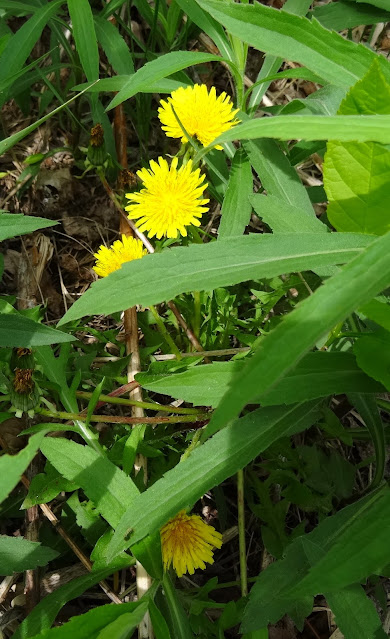7/11/2023
5/17/2023
7/07/2022
culver's root
6/01/2022
5/12/2022
nectar and pollen
9/20/2021
purple asters
9/12/2021
bee on asters
The asters are abuzz with pollinators. While standing among the wildflowers, I hear the buzzing as loud and pleasant. There are many Panicled Aster Symphyotrichum lanceolatum plants in the riparian area around the pond. The nectar and pollen of the flowerheads attract many kinds of insects, including honeybees, bumblebees, wasps, flies, butterflies, skippers, and beetles. I have not seen any Wild Turkey here, but they feed on the seeds and foliage of aster plants. Maybe some day . . .
7/20/2021
evening primrose
7/07/2021
white wildflowers
Sitting near the pond, one can gaze out at flowering plants among the green grasses, rushes, and reeds. Mountain Mint, Swamp Milkweed, and Queen Anne's Lace are among the ones blooming now.
7/04/2021
yellow loosestrife
Small yellow wildflowers, brightening the green grasses and rushes around the pond now, are River Loosestrife Lysimachia hybrida, or Lowland Yellow Loosestrife. This plant bloomed last year, and came back stronger with more stems this season. Lysmachias produce floral oil rather than nectar. These plants are also pollen hosts for Macropis bees; the bees specialize in using a mixture of pollen and floral oil to produce offspring. read more at U of MN Extension
8/25/2020
goldenrod
To complement all the blue and purple flowers around the pond this week, the Goldenrod has unfurled its blooms. Solidago species, commonly called Goldenrods, are in a genus of more than 100 species of flowering plants in the aster family, Asteraceae.
Goldenrods are often blamed for allergies, but they have sticky pollen and rely on insects to move most of it. The wind borne pollen of ragweeds and pigweeds are to blame for 'hay fever' in late summer.
These plants are habitat for a large number of insect species. Blooming in late summer, they are a critical nectar source for many bees, butterflies, and moths to fortify themselves before freezing weather comes.
8/11/2020
ladybug on Mountain Mint
8/06/2020
Monarch butterfly caterpillars

 |
8/04/2020
7/12/2020
Mountain Mint blooming
Blooming now in the riparian buffer around the pond - - Virginia Mountain Mint, Pycnanthemum virginianum. Look for them as 2 or 3 foot tall bushy plants. Because the individual flowers are tiny, this plant is an important food for short-tongued bees. They can reach into the flowers easily to drink the nectar. In the photo above, you can see the clusters of tiny white flowers with delicate purple spots. The flowers open one at a time, providing nectar over many days.
Below, this subtle plant grows among yellow Birdsfoot Trefoil and daisy-like Fleabane.
6/13/2020
alfalfa
6/12/2020
Alsike Clover
 Clover is a forage crop around the world. But it readily escapes cultivation, so it is common in meadows and in disturbed places. This pond and surrounding wetland was disturbed during transition to a neighborhood, and some native plant seed was sown. So, we have clover.
Clover is a forage crop around the world. But it readily escapes cultivation, so it is common in meadows and in disturbed places. This pond and surrounding wetland was disturbed during transition to a neighborhood, and some native plant seed was sown. So, we have clover.Alsike Clover Trifolium hybridum flowers are light pink turning darker pink with age, giving the head a distinct two-tone color pattern as lower blossoms on the globe mature first.
Clover is one of the main nectar sources for honeybees. The resident Muskrats are very fond of clover. We see them swimming across the pond, picking a bunch of clover stems and leaves with flowers, then swimming back across the pond to their burrow.
5/27/2020
early meadow rue
Early Meadow Rue Thalictrum dioicum is also called Quicksilver Weed. The small flowers will open into fuzzy clusters. The foliage is a pleasing blue-green color. This specimen is coming up among other plants hiding beneath the young trees. Early Meadow Rue often likes moist partly shaded areas, so this one will thrive in the position it has chosen near the pond.
10/02/2017
migrating painted ladies
The garden was aflutter last week with Painted Lady butterflies Vanessa cardui. They were obsessed with the blossoms of Brazilian Vervain Verbena bonariensis. Fortunately, the lavender blooms are abundant this year, probably self-seeded from last year's single pot of the plant. I was beginning to think I had too many of the tall strong stems topped with airy umbrellas of tiny flowers. Now, glad they invited the ladies to stop for refueling on their way south!
5/29/2017
bee on cranesbill
While admiring the Cranesbill 'Karmina' in the gardens today, I noticed a fuzzy bee hurrying from one to another of the blooms that are just beginning to open. I believe it is a Carpenter Bee Xylocopa virginica, commonly a nester in various types of wood; they eat pollen and nectar.






























